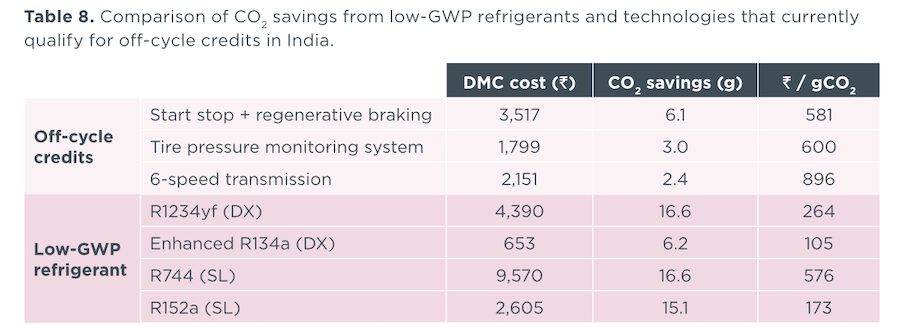White paper
Integrating refrigerants with low global warming potential into India’s light vehicle fuel efficiency standards
India’s light vehicle fuel consumption standards currently ignore both direct and indirect emissions from mobile air conditioning (MAC) systems. The MAC does not operate during the official tests that determine compliance and neither climate-friendly refrigerants nor MAC efficiency improvements are included in the off-cycle credits system offered under the standards. The regulations can be amended, though, and to help understand the benefits, this paper evaluates the emissions reductions and costs of four different improved MAC systems versus the R134a systems currently prevalent in India: an enhanced R134a system with reduced leakage and improved efficiency, and systems that use R152a, R744, and R1234yf.
Results show that R1234yf has the most potential for the Indian market. This is a near drop-in replacement for R134a and does not require any significant hardware change. While R1234yf in a direct expansion (DX) system and R152a in a secondary loop (SL) system both offer significant, and roughly equivalent, reductions in lifetime greenhouse gas emissions, R152a in an SL system has thus far only been demonstrated in India in a prototype vehicle and it has not been adopted in production vehicles anywhere in the world. R1234yf, meanwhile, is widely used in new vehicles in the United States, Europe, and Japan. The cost of R1234yf is currently an obstacle in India, however, and it is 10 times higher than R134a and R152a due to protection from several patents. As shown in the table below, even though R1234yf is cost-effective per g CO2 emissions reduction, its direct manufacturing cost (DMC) is higher than the other technologies that currently qualify for off-cycle credits in India.

From a vehicle manufacturing standpoint, the results suggest that future regulations in India need not distinguish between MAC systems using refrigerants with a global warming potential (GWP) less than 150. For Indian temperature conditions, R152a and R1234yf can be effective in reducing emissions and are thus worthy of CO2 credits for direct and indirect emissions reduction in India’s fuel consumption standards. Indirect credits should be based on the percentage reduction in CO2 emissions when accounting for MAC use during certified testing and should be confirmed using test procedures representative of real-world use like the U.S. Environmental Protection Agency’s test procedure to validate indirect credits, AC17.